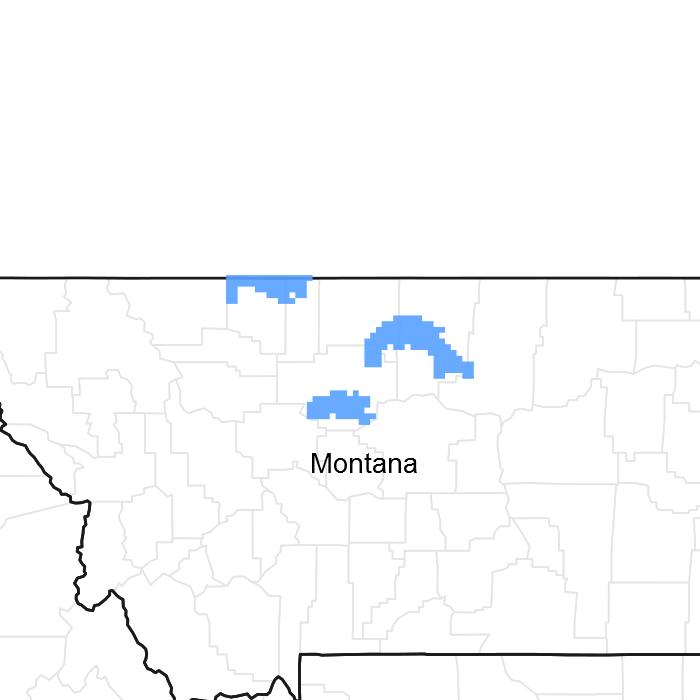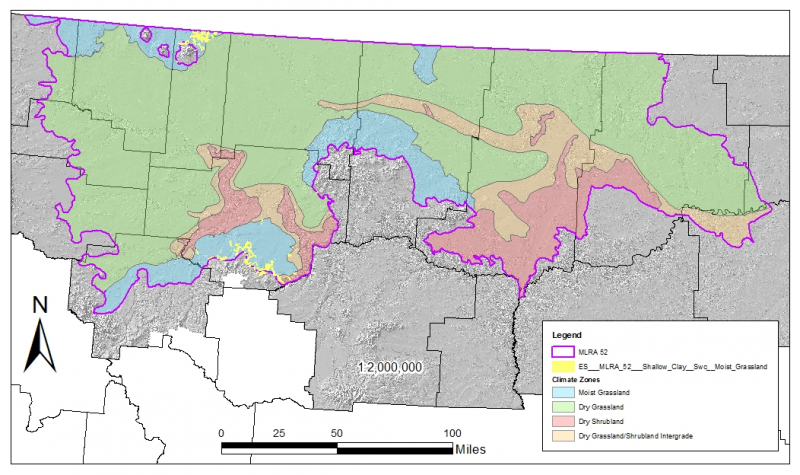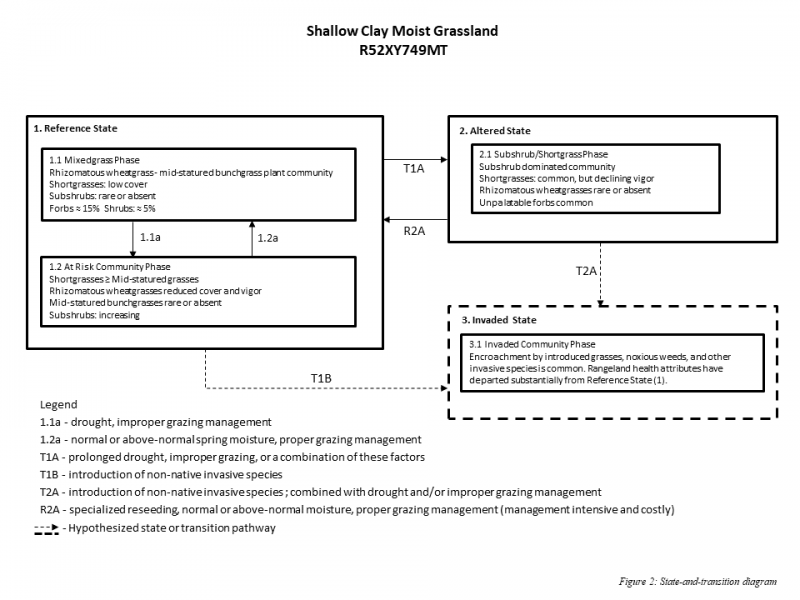Other references
Adams, B.W., et al. 2013. Rangeland plant communities for the mixedgrass natural subregion of Alberta. Second approximation. Rangeland Management Branch, Policy Division, Alberta Environment and Sustainable Resource Development, Lethbridge, Pub. No. T/039.
Anderson, R.C. 2006. Evolution and origin of the central grassland of North America: Climate, fire, and mammalian grazers. Journal of the Torrey Botanical Society 133:626-647.
Baskin, J.M., and C.C. Baskin. 1981. Ecology of germination and flowering in the weedy winter annual grass Bromus japonicus. Journal of Range Management 34:369-372.
Biondini, M.E., and L. Manske. 1996. Grazing frequency and ecosystem processes in a northern mixed prairie, USA. Ecological Applications 6:239-256.
Biondini, M.E., B.D. Patton, and P.E. Nyren. 1998. Grazing intensity and ecosystem processes in a northern mixed-grass prairie, USA. Ecological Applications 8:469-479.
Bloom-Cornelius, I.V. 2011. Vegetation response to fire and domestic and native ungulate herbivory in a Wyoming big sagebrush ecosystem. M.S. thesis, Oklahoma State University. Stillwater, OK.
Bragg, T.B. 1995. The physical environment of the Great Plains grasslands. In: A. Joern and K.H. Keeler (eds.) The Changing Prairie, Oxford University Press, Oxford, pp. 49-81.
Branson, D.H., and G.A. Sword. 2010. An experimental analysis of grasshopper community responses to fire and livestock grazing in a northern mixed-grass prairie. Environmental Entomology 39:1441-1446.
Bylo, L.N., N. Koper, and K.A. Molloy. 2014. Grazing intensity influences ground squirrel and American badger habitat use in mixed-grass prairies. Rangeland Ecology and Management 67:247-254.
Christian, J.M., and S.D. Wilson. 1999. Long-term ecosystem impacts of an introduced grass in the Northern Great Plains. Ecology 80:2397-2407.
Clarke, S.E, E.W. Tisdale, and N.A. Skoglund. 1947. The effects of climate and grazing practices on short-grass prairie vegetation in southern Alberta and southwestern Saskatchewan. Canadian Department of Agriculture Technical Bulletin No. 46.
Cleland, D.T., et al. 1997. National hierarchical framework of ecological units. In: M.S. Boyce and A. Haney (eds.) Ecosystem Management Applications for Sustainable Forest and Wildlife Resources, Yale University Press, New Haven, CT.
Cooper, S.V., C. Jean, and P. Hendricks. 2001. Biological survey of a prairie landscape in Montana’s glaciated plains. Report to the Bureau of Land Management. Montana Natural Heritage Program, Helena, MT.
Cooper, S.V., and W.M. Jones. 2003. Site descriptions of high-quality wetlands derived from existing literature sources. Report to the Montana Department of Environmental Quality. Montana Natural Heritage Program, Helena, MT.
Coupland, R.T. 1950. Ecology of the mixed prairie of Canada. Ecological Monographs 20:271-315.
Coupland, R.T. 1958. The effects of fluctuations in weather upon the grasslands of the Great Plains. Botanical Review 24:273-317.
Coupland, R.T. 1961. A reconsideration of grassland classification in the Northern Great Plains of North America. Journal of Ecology 49:135-167.
Coupland, R.T., and R.E. Johnson. 1965. Rooting characteristics of native grassland species in Saskatchewan. Journal of Ecology 53:475-507.
Cowardin, L.M., V. Carter, F.C. Golet, and E.T. LaRoe. 1979. Classification of wetlands and deepwater habitats of the United States. US Fish and Wildlife Service FWS/OBS, 79(31), 131.
Crowe, E., and G. Kudray. 2003. Wetland Assessment of the Whitewater Watershed. Report to U.S. Bureau of Land Management, Malta Field Office. Montana Natural Heritage Program, Helena, MT.
Davis, S.K., R.J. Fisher, S.L. Skinner, T.L. Shaffer, and R.M. Brigham. 2013. Songbird abundance in native and planted grassland varies with type and amount of grassland in the surrounding landscape. Journal of Wildlife Management 77:908-919.
DeKeyser, E.S., M. Meehan, G. Clambey, and K. Krabbenhoft. 2013. Cool season invasive grasses in northern Great Plains natural areas. Natural Areas Journal 33:81-90.
DeKeyser, S., G. Clambey, K. Krabbenhoft, and J. Ostendorf. 2009. Are changes in species composition on central North Dakota rangelands due to non-use management? Rangelands 31:16-19.
Derner, J.D., and R.H. Hart. 2007. Grazing-induced modifications to peak standing crop in northern mixed-grass prairie. Rangeland Ecology and Management 60:270-276.
Derner, J.D., and A.J. Whitman. 2009. Plant interspaces resulting from contrasting grazing management in northern mixed-grass prairie: Implications for ecosystem function. Rangeland Ecology and Management 62:83-88.
Derner, J.D., W.K. Lauenroth, P. Stapp, and D.J. Augustine. 2009. Livestock as ecosystem engineers for grassland bird habitat in the western Great Plains of North America. Rangeland Ecology and Management 62:111-118.
Dix, R.L. 1960. The effects of burning on the mulch structure and species composition of grasslands in western North Dakota. Ecology 41:49-56.
Dormaar, J.F., and S. Smoliak. 1985. Recovery of vegetative cover and soil organic matter during revegetation of abandoned farmland in a semiarid climate. Journal of Range Management 38:487-491.
Dormaar, J.F., and W.D. Willms. 1990. Effect of grazing and cultivation on some chemical properties of soils in the mixed prairie. Journal of Range Management 43:456-460.
Dormaar, J.F., B.W. Adams, and W.D. Willms. 1994. Effect of grazing and abandoned cultivation on a Stipa-Bouteloua community. Journal of Range Management 47:28-32.
Dormaar, J.F., M.A. Naeth, W.D. Willms, and D.S. Chanasyk. 1995. Effect of native prairie, crested wheatgrass (Agropyron cristatum) and Russian wildrye (Elymus junceus) on soil chemical properties. Journal of Range Management 48:258-263.
Fansler, V.A., and J.M. Mangold. 2010. Restoring native plants to crested wheatgrass stands. Restoration Ecology 19:16-23.
Federal Geographic Data Committee. 2008. The National Vegetation Classification Standard, Version 2. FGDC Vegetation Subcommittee. FGDC-STD-005-2008 (Version 2). pp. 126.
Fullerton, D.S., and R.B. Colton. 1986. Stratigraphy and correlation of the glacial deposits on the Montana Plains. U.S. Geological Survey.
Fullerton, D.S., R.B. Colton, C.A. Bush, and A.W. Straub. 2004. Map showing spatial and temporal relations of mountain and continental glaciations on the northern plains, primarily in northern Montana and northwestern North Dakota. U.S. Geologic Survey pamphlet accompanying Scientific Investigations Map 2843.
Fullerton, D.S., R.B. Colton, and C.A. Bush. 2013. Quaternary geologic map of the Shelby 1° x 2° quadrangle, Montana: U.S. Geological Survey Open-File Report 2012–1170, scale 1:250,000.
Galatowitsch, S.M., and A.G. Van der Valk. 1996. The vegetation of restored and natural prairie wetlands. Ecological Applications. 6:1 pp.102-112.
Gilbert, M.C., P.M. Whited, E.J. Clairain Jr., and R.D. Smith. 2006. A regional guidebook for applying the hydrogeomorphic approach to assessing wetland functions of prairie potholes. U.S. Army Corps of Engineers Final Report, Washington, DC.
Grant, T.A., B. Flanders-Wanner, T.L. Shaffer, R.K. Murphy, and G.A. Knutsen. 2009. An emerging crisis across northern prairie refuges: Prevalence of invasive plants and a plan for adaptive management. Ecological Restoration 27:58-65.
Haferkamp, M.R., R.K. Heitschmidt, and M.G. Karl. 1997. Influence of Japanese brome on western wheatgrass yield. Journal of Range Management 50:44-50.
Hansen, P.L., et al. 1995. Classification and management of Montana's riparian and wetland sites. University of Montana, Montana Forest and Conservation Experiment Station, Miscellaneous Publication No. 54.
Harmoney, K.R. 2007. Grazing and burning Japanese brome (Bromus japonicus) on mixed grass rangelands. Rangeland Ecology and Management 60:479-486.
Hart, M., S.S. Waller, S.R. Lowry, and R.N. Gates. 1985. Disking and seeding effects on sod bound mixed prairie. Journal of Range Management 38:121-125.
Heidel, B., S.V. Cooper, and C. Jean. 2000. Plant species of special concern and plant associations of Sheridan County, Montana. Report to U.S. Fish and Wildlife Service. Montana Natural Heritage Program, Helena, MT.
Heidinga, L., and S.D. Wilson. 2002. The impact of an invading alien grass (Agropyron cristatum) on species turnover in native prairie. Diversity and Distributions 8:249-258.
Heitschmidt, R.K., and L.T. Vermeire. 2005. An ecological and economic risk avoidance drought management decision support system. In: J.A. Milne (ed.) Pastoral Systems in Marginal Environments, XXth International Grasslands Congress, July 2005, p. 178.
Henderson, A.E., and S.K. Davis. 2014. Rangeland health assessment: A useful tool for linking range management and grassland bird conservation? Rangeland Ecology and Management 67:88-98.
Henderson, D.C., and M.A. Naeth. 2005. Multi-scale impacts of crested wheatgrass invasion in mixed-grass prairie. Biological Invasions 7:639-650.
Herrick, J.E., J.W. Van Zee, K.M. Havstad, L.M. Burkett, and W.G. Whitford. 2009. Monitoring manual for grassland, shrubland and savanna ecosystems. U.S. Department of Agriculture, Agricultural Research Service, Jornada Experimental Range, Las Cruces, NM.
Higgins, K.F. 1986. Interpretation and compendium of historical fire accounts in the Northern Great Plains. U.S. Fish and Wildlife Service Resource Publication 161.
Holechek, J.L. 1981. Crested wheatgrass. Rangelands 3:151-153.
Howard, J.L. 1999. Artemisia tridentata subsp. wyomingensis. In: Fire Effects Information System, U.S. Department of Agriculture, Forest Service http://www.fs.fed.us/database/feis/plants/shrub/arttriw/all.html accessed (8/11/2016).
Joern, A. 2005. Disturbance by fire frequency and bison grazing modulate grasshopper assemblages in tallgrass prairie. Ecology 86:861-873.
Jones, W.M. 2004. Using vegetation to assess wetland condition: a multimetric approach for temporarily and seasonally flooded depressional wetlands and herbaceous-dominated intermittent and ephemeral riverine wetlands in the northwestern glaciated plains ecoregion, Montana. Report to the Montana Department of Environmental Quality and the U.S. Environmental Protection Agency. Montana Natural Heritage Program, Helena, MT.
Knopf, F.L. 1996. Prairie legacies—birds. In: F.B. Samson and F.L. Knopf (eds.) Prairie Conservation: Preserving North America’s Most Endangered Ecosystem, Island Press, Washington, DC, pp. 135-148.
Knopf, F.L., and F.B. Samson. 1997. Conservation of grassland vertebrates. In: F.B. Samson and F.L. Knopf (eds.) Ecology and Conservation of Great Plains Vertebrates: Ecological Studies 125, Springer-Verlag, New York, NY, pp. 273-289.
Krzic, M., K. Broersma, D.J. Thompson, and A.A. Bomke. 2000. Soil properties and species diversity of grazed crested wheatgrass and native rangelands. Journal of Range Management 53:353-358.
Lacey, J., R. Carlstrom, and K. Williams. 1995. Chiseling rangeland in Montana. Rangelands 17:164-166.
Lauenroth, W.K., O.E. Sala, D.P. Coffin, and T.B. Kirchner. 1994. The importance of soil water in recruitment of Bouteloua gracilis in the shortgrass steppe. Ecological Applications 4:741-749.
Laycock, W.A. 1988. History of grassland plowing and grass planting on the Great Plains. In: J.E. Mitchell (ed.) Impacts of the Conservation Reserve Program in the Great Plains—Symposium Proceedings, September 16-18, 1987. USDA Forest Service, Rocky Mountain Forest and Range Experiment Station, General Technical Report RM-158.
Laycock, W.A. 1991. Stable states and thresholds of range condition on North American rangelands. Journal of Range Management 44:427-433.
Lesica, P., and P. Husby. 2006. Field Guide to Montana’s Wetland Vascular Plants. Montana Wetlands Trust. Helena, MT.
Lesica, P., and T.H. DeLuca. 1996. Long-term harmful effects of crested wheatgrass on Great Plains grassland ecosystems. Journal of Soil and Water Conservation 51:408-409.
Lockwood, J.A. 2004. Locust: The devastating rise and mysterious disappearance of the insect that shaped the American frontier. Basic Books, New York, NY.
Looman, J., and D.H. Heinrichs. 1973. Stability of crested wheatgrass pastures under long-term pasture use. Canadian Journal of Plant Science 53:501-506.
Madden, E.M., R.K. Murphy, A.J. Hansen, and L. Murray. 2000. Models for guiding management of prairie bird habitat in northwestern North Dakota. American Midland Naturalist 144:377-392.
McNab, W.H., et al. 2007. Description of ecological subregions: Sections of the conterminous United States [CD-ROM]. USDA Forest Service, General Technical Report WO-76B.
McIntyre, C., K. Newlon, L. Vance, and M. Burns. 2011. Milk, Marias, and St. Mary monitoring: developing a long-term rotating basin wetland assessment and monitoring strategy for Montana. Report to the United States Environmental Protection Agency. Montana Natural Heritage Program, Helena, MT.
Miller, J.J., and J.A. Brierley. 2011. Solonetzic soils of Canada: Genesis, distribution, and classification. Canadian Journal of Soil Science 91:889-902.
Montana State College. 1949. Similar vegetative rangeland types in Montana. Montana State College, Agricultural Experiment Station.
Mushet, D.M., N.H. Euliss, Jr., and C.A. Stockwell. 2012. A conceptual model to facilitate amphibian conservation in the Northern Great Plains. Great Plains Research 22:45-58.
Nesser, J.A., G.L. Ford, C.L. Maynard, and D.S. Page-Dumroese. 1997. Ecological units of the Northern Region: Subsections. USDA Forest Service, Intermountain Research Station, General Technical Report INT-GTR-369.
Oard, M.J. 1993. A method of predicting chinook winds east of the Montana Rockies. Weather and Forecasting 8:166-180.
Ogle, S.M., W.A. Reiners, and K.G. Gerow. 2003. Impacts of exotic annual brome grasses (Bromus spp.) on ecosystem properties of the northern mixed grass prairie. American Midland Naturalist 149:46-58.
Roath, L.R. 1988. Implications of land conversions and management for the future. In: J.E. Mitchell (ed.) Impacts of the Conservation Reserve Program in the Great Plains—Symposium Proceedings, September 16-18, 1987. USDA Forest Service, Rocky Mountain Forest and Range Experiment Station, General Technical Report RM-158.
Rogler, G.A., and R.J. Lorenz. 1983. Crested wheatgrass: Early history in the United States. Journal of Range Management 36:91-93.
Romo, J.T. 2011. Clubmoss, precipitation, and microsite effects on emergence of graminoid and forb seedlings in the semiarid northern mixed prairie of North America. Journal of Arid Environments 75:98-105.
Rowe, J.S. 1969. Lightning fires in Saskatchewan grassland. Canadian Field Naturalist 83:317-327.
Salo, E.D., et al. 2004. Grazing intensity effects on vegetation, livestock and non-game birds in North Dakota mixed-grass prairie. Proceedings of the 19th North American Prairie Conference, Madison, WI.
Samuel, M.J., and R.H. Hart. 1994. Sixty-one years of secondary succession on rangelands of the Wyoming High Plains. Journal of Range Management 47:184-191.
Semlitsch, R.D. 2000. Principles for management of aquatic-breeding amphibians. Journal of Wildlife Management 64:615-631.
Shay, J., D. Kunec, and B. Dyck. 2001. Short-term effects of fire frequency on vegetation composition and biomass in mixed prairie in south-western Manitoba. Plant Ecology 155:157-167.
Smith, B., and G.J. McDermid. 2014. Examination of fire-related succession within the dry mixed-grass subregion of Alberta with the use of MODIS and Landsat. Rangeland Ecology and Management 67:307-317.
Smith, R.E. 2013. Conserving Montana’s sagebrush highway: Long distance migration in sage-grouse. M.S. thesis, University of Montana, Missoula, MT.
Smoliak, S. 1974. Range vegetation and sheep production at three stocking rates on Stipa-Bouteloua prairie. Journal of Range Management 27:23-26.
Smoliak, S., and J.F. Dormaar. 1985. Productivity of Russian wildrye and crested wheatgrass and their effect on prairie soils. Journal of Range Management 38:403-405.
Smoliak, S., J.F. Dormaar, and A. Johnston. 1972. Long-term grazing effects on Stipa-Bouteloua prairie soils. Journal of Range Management 25:246-250.
Soil Survey Staff. 2014. Keys to soil taxonomy, 12th edition. USDA Natural Resources Conservation Service.
Soller, D.R. 2001. Map showing the thickness and character of Quaternary sediments in the glaciated United States east of the Rocky Mountains. U.S. Geological Survey Miscellaneous Investigations Series I-1970-E, scale 1:3,500,000.
Stephens, S.E., J.J. Rotella, M.S. Lindberg, M.L. Taper, and J.K. Ringelman. 2005. Duck nest survival in the Missouri Coteau of North Dakota: Landscape effects at multiple spatial scales. Ecological Applications 15:2137-2149.
Stewart, R.E., and H.A. Kantrud. 1971. Classification of natural ponds and lakes in the glaciated prairie region. No. 92. US Fish and Wildlife Service, Bureau of Sport Fisheries and Wildlife.
Tiner, R.W. 2003. Correlating Enhanced National Wetlands Inventory Data with Wetland Functions for Watershed Assessments: A Rationale for Northeastern U.S. Wetlands. U.S. Fish and Wildlife Service, National Wetlands Inventory Program, Region 5, Hadley, MA. http://www.fws.gov/northeast/wetlands/pdf/CorrelatingEnhancedNWIDataWetlandFunctions WatershedAssessments[1].pdf.
Toledo, D., M. Sanderson, K. Spaeth, J. Hendrickson, and J. Printz. 2014. Extent of Kentucky bluegrass and its effect on native plant species diversity and ecosystem services in the Northern Great Plains of the United States. Invasive Plant Science and Management 7:543-552.
Umbanhowar, Jr., C.E. 2004. Interactions of climate and fire at two sites in the Northern Great Plains. Palaeogeography, Palaeoclimatology, and Palaeoecology 208:141-152.
U.S. Department of Agriculture, Natural Resources Conservation Service. Glossary of landform and geologic terms. National Soil Survey Handbook, Title 430-VI, Part 629.02c. http://www.nrcs.usda.gov/wps/portal/nrcs/detail/soils/ref/?cid=nrcs142p2_054242 (Accessed 13 April 2016).
USDA Natural Resources Conservation Service. 2016. Plant guide for broom snakeweed. Available online at: http://plants.usda.gov/plantguide/pdf/cs_gusa2.pdf. (Accessed April 22, 2016.).
U.S. Fish and Wildlife Service. 2013. Greater sage-grouse (Centrocercus urophasianus)
conservation objectives: Final report.
Vance, L., S. Owen, and J. Horton. 2013. Literature review: Hydrology-ecology relationships in Montana prairie wetlands and intermittent/ephemeral streams. Report to the Cadmus Group and the U.S. Environmental Protection Agency. Montana Natural Heritage Program, Helena, MT.
Van Dyne, G.M., and W.G. Vogel. 1967. Relation of Selaginella densa to site, grazing, and climate. Ecology 48:438-444.
Vaness, B.M., and S.D. Wilson. 2007. Impact and management of crested wheatgrass (Agropyron cristatum) in the northern Great Plains. Canadian Journal of Plant Science 87:1023-1028.
Vermeire, L.T., J.L. Crowder, and D.B. Wester. 2011. Plant community and soil environment response to summer fire in the northern Great Plains. Rangeland Ecology & Management 64:37-46.
Vermeire, L.T., J.L. Crowder, and D.B. Wester. 2014. Semiarid rangeland is resilient to summer fire and postfire grazing utilization. Rangeland Ecology & Management 67:52-60.
Vuke, S.M., K.W. Porter, J.D. Lonn, and D.A. Lopez. 2007. Geologic map of Montana - information booklet: Montana Bureau of Mines and Geology Geologic Map 62-D.
Wambolt, C.L., K.S. Walhof, and M.R. Frisina. 2001. Recovery of big sagebrush communities after burning in south-western Montana. Journal of Environmental Management. 61:243-252.
Watts, M.J., and C.L. Wambolt. 1996. Long-term recovery of Wyoming big sagebrush after four treatments. Journal of Environmental Management 46:95-102.
Whisenant, S.G. 1990. Postfire population dynamics of Bromus japonicus. American Midland Naturalist 123:301-308.
Wilson, S.D., and J.M. Shay. 1990. Competition, fire, and nutrients in a mixed-grass prairie. Ecology 71:1959-1967.
With, K.A. 2010. McCown's longspur (Rhynchophanes mccownii). In: A. Poole (ed.) The Birds of North America (online), Cornell Lab of Ornithology, Ithaca. http://bna.birds.cornell.edu/bna/species/09.



